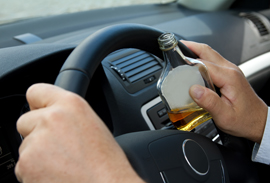
At-risk young adults who scored higher than their peers on a questionnaire that measures impulsive personality traits had a higher chance of engaging in reckless and impaired driving, according to a study by researchers at the National Institutes of Health and other institutions. If confirmed by other studies, these findings could serve as the basis for developing a screening test to identify impulsive young drivers who could benefit from prevention programs to reduce risky behaviors.
The study was conducted by Jeremy W. Luk, Ph.D., of NIH’s Eunice Kennedy Shriver National Institute of Child Health and Human Development and colleagues. It appears in Personality and Individual Differences.
Background
The study authors noted that earlier research has shown that young adults are more likely to engage in risky driving than individuals of other age groups and that nearly 14 percent of U.S. traffic deaths in 2013 involved young adults. Previous studies also have found that impulsivity is associated with risky driving in young adults. However, these earlier studies have been conducted largely among college students, and it is not known whether their results apply to other groups, such as young adults with a history of substance use and behavioral problems.
Impulsivity is thought to be a complex personality trait with several distinct facets. The researchers relied on the UPPS-P model to evaluate impulsivity among participants in their study. The model describes impulsivity as having these components:
- Negative urgency—tendency to act rashly in the face of strong negative emotions
- Positive urgency—tendency to act rashly in the face of strong positive emotions
- Lack of premeditation—tendency to act without regard to consequences
- Lack of perseverance—inability to remain with a task until completion
- Sensation seeking—tendency to seek excitement and novel experiences
The researchers administered a questionnaire to 1,100 young adults from 18 to 30 years of age who were in either a residential or outpatient drug treatment program, who had been involved with the criminal justice system, or who had attended a school for teens with behavioral problems. For each impulsivity facet, the participants were asked to state how strongly they agreed or disagreed with a given statement. For example, participants responded to statements such as “My thinking is usually careful and purposeful” and “Before making up my mind, I consider all advantages and disadvantages.”
To determine if they had driven recklessly, the participants were asked if they had taken chances in the past year while driving a car, motorcycle, or other vehicle—such as speeding through a city. To determine if they had driven under the influence, participants were asked if they had driven a car, motorcycle, boat, or other vehicle in the past year when they were high or drowsy because of alcohol or drug consumption.
Results
The higher a participant scored on any of the impulsivity facets, the more likely they were than their peers to have either driven recklessly or under the influence or both. Sensation seeking and negative urgency were associated with higher risk for both reckless driving and driving under the influence of alcohol and/or drugs. Young adults who scored high on lack of premeditation were at greater risk than their peers for reckless driving, and young adults who scored high on lack of perseverance were at higher risk for driving under the influence. Those who scored high on both sensation seeking and lack of premeditation were at the greatest risk for driving under the influence than peers who scored lower in these personality facets.
Significance
"Our findings suggest that the ability to pause and think before acting is linked to both types of reckless driving behaviors among high-risk young adults, but in different ways," Dr. Luk said. "For most of the young adults, scoring high in sensation seeking increased the risk for driving under the influence—except for those who also scored high in premeditation. In other words, the ability to pause and think before acting appeared to reduce the tendency of sensation seekers to drive under the influence.
Next Steps
The researchers hope that the UPPS-P scale could one day be used to identify youth at risk for driving under the influence or driving recklessly and that interventions could be developed to reduce this risk.
Reference
Luk, JW, et al. Unique and interactive effects of impulsivity facets on reckless driving and driving under the influence in a high-risk young adult sample. Personality and Individual Differences http://doi.org/10.1016/j.paid.2017.03.048 

 BACK TO TOP
BACK TO TOP